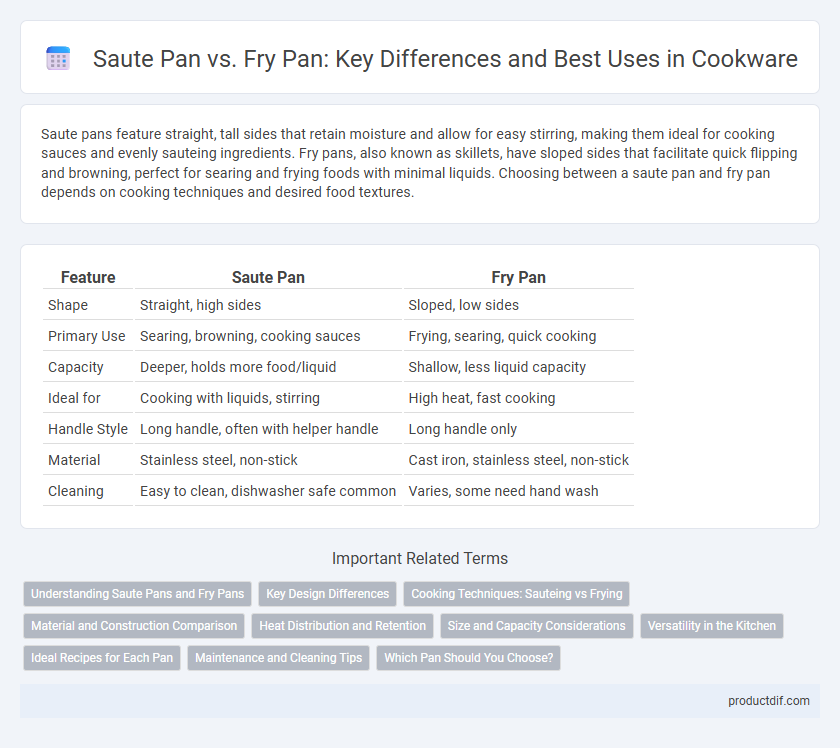Saute pans feature straight, tall sides that retain moisture and allow for easy stirring, making them ideal for cooking sauces and evenly sauteing ingredients. Fry pans, also known as skillets, have sloped sides that facilitate quick flipping and browning, perfect for searing and frying foods with minimal liquids. Choosing between a saute pan and fry pan depends on cooking techniques and desired food textures.
Table of Comparison
| Feature | Saute Pan | Fry Pan |
|---|---|---|
| Shape | Straight, high sides | Sloped, low sides |
| Primary Use | Searing, browning, cooking sauces | Frying, searing, quick cooking |
| Capacity | Deeper, holds more food/liquid | Shallow, less liquid capacity |
| Ideal for | Cooking with liquids, stirring | High heat, fast cooking |
| Handle Style | Long handle, often with helper handle | Long handle only |
| Material | Stainless steel, non-stick | Cast iron, stainless steel, non-stick |
| Cleaning | Easy to clean, dishwasher safe common | Varies, some need hand wash |
Understanding Saute Pans and Fry Pans
Saute pans feature straight, vertical sides and a larger surface area, making them ideal for cooking techniques that require tossing or stirring ingredients without spilling. Fry pans, also called skillets, have sloped sides designed to facilitate quick flipping and easy access for frying, searing, or browning. Choosing between a saute pan and fry pan depends on the cooking method, with saute pans suited for simmering sauces and frying pans optimized for high-heat tasks.
Key Design Differences
Saute pans feature straight, tall sides designed to retain liquids and facilitate tossing, while fry pans have low, flared sides for easy access and quick evaporation. The thicker, heavier base of a saute pan ensures even heat distribution for simmering and deglazing, whereas the fry pan's lighter, flatter base excels at high-heat searing and frying. Ergonomic handles on both vary in length and grip to optimize control based on their specific cooking techniques.
Cooking Techniques: Sauteing vs Frying
Saute pans, with their wide flat bottom and tall, straight sides, are designed for sauteing, allowing food to cook quickly over high heat with minimal oil while enabling easy tossing and stirring. Fry pans, also known as skillets, feature a wider base and lower, sloped sides, making them ideal for frying techniques that require shallow oil and even browning over medium to high heat. Choosing between a saute pan and fry pan depends on the cooking method: saute pans excel for precise, fast cooking of vegetables or proteins, while fry pans are better suited for browning, searing, and frying tasks.
Material and Construction Comparison
Saute pans typically feature straight sides and a thicker base, often constructed from stainless steel or hard-anodized aluminum for even heat distribution and durability, ideal for deglazing and cooking liquids. Fry pans usually have sloped sides and may use lighter materials like aluminum or non-stick coatings for quick, high-heat searing and easy food release. Construction differences impact heat retention and cooking versatility, with saute pans offering superior heat stability and fry pans excelling in rapid frying and flipping.
Heat Distribution and Retention
Saute pans feature thicker, often multi-layered bottoms that provide superior heat distribution and retention, ensuring even cooking and preventing hot spots during frying or browning. Fry pans, typically lighter with thinner bases, heat up quickly but may have uneven temperature zones, making them less ideal for dishes requiring sustained, consistent heat. Optimal heat management in saute pans enhances flavor development and texture, especially in recipes that demand precise temperature control.
Size and Capacity Considerations
Saute pans typically feature taller sides and a larger surface area, offering greater capacity for cooking larger quantities and preventing food from spilling during stirring. Fry pans or skillets have lower, sloped sides designed for quick, high-heat cooking with easier access to flip or turn food, but generally hold less volume. Choosing between a saute pan and fry pan depends on the cookware size needed to accommodate portion size and cooking technique demands.
Versatility in the Kitchen
Saute pans offer greater versatility in the kitchen due to their higher, straight sides which allow for easy tossing and deglazing, making them ideal for cooking sauces and dishes that require liquid retention. Fry pans, with their lower, sloped sides, excel at frying and searing by providing better moisture evaporation and easy access for flipping food. Choosing between a saute pan and a fry pan depends on the cooking techniques you frequently use, with saute pans suited for sauteing and simmering, while fry pans are optimized for high-heat cooking like frying and browning.
Ideal Recipes for Each Pan
Saute pans excel at cooking dishes that require even heat distribution and frequent stirring, such as stir-fries, vegetable sautes, and reductions. Fry pans are ideal for recipes needing a larger flat surface and quick searing, including pancakes, eggs, and pan-fried meats. Choosing the right pan enhances cooking efficiency and the flavor profile of various recipes.
Maintenance and Cleaning Tips
Saute pans feature straight sides that minimize food spillage and require thorough cleaning to prevent residue buildup along the edges, while fry pans with sloped sides generally facilitate easier wiping of surfaces. Non-stick saute and fry pans should be cleaned with gentle, non-abrasive sponges and mild detergents to preserve the coating and avoid scratches. Regular seasoning of stainless steel versions enhances durability and prevents rust, ensuring long-lasting performance despite frequent use.
Which Pan Should You Choose?
Choose a saute pan for recipes requiring even heat distribution and high sides to contain liquids, ideal for simmering sauces or tossing ingredients. Opt for a fry pan when you need quick, high-heat cooking with easy access and shallow sides, perfect for searing, frying, or browning. Understanding these functional differences ensures the right choice for your cooking style and recipe needs.
Saute Pan vs Fry Pan Infographic

 productdif.com
productdif.com